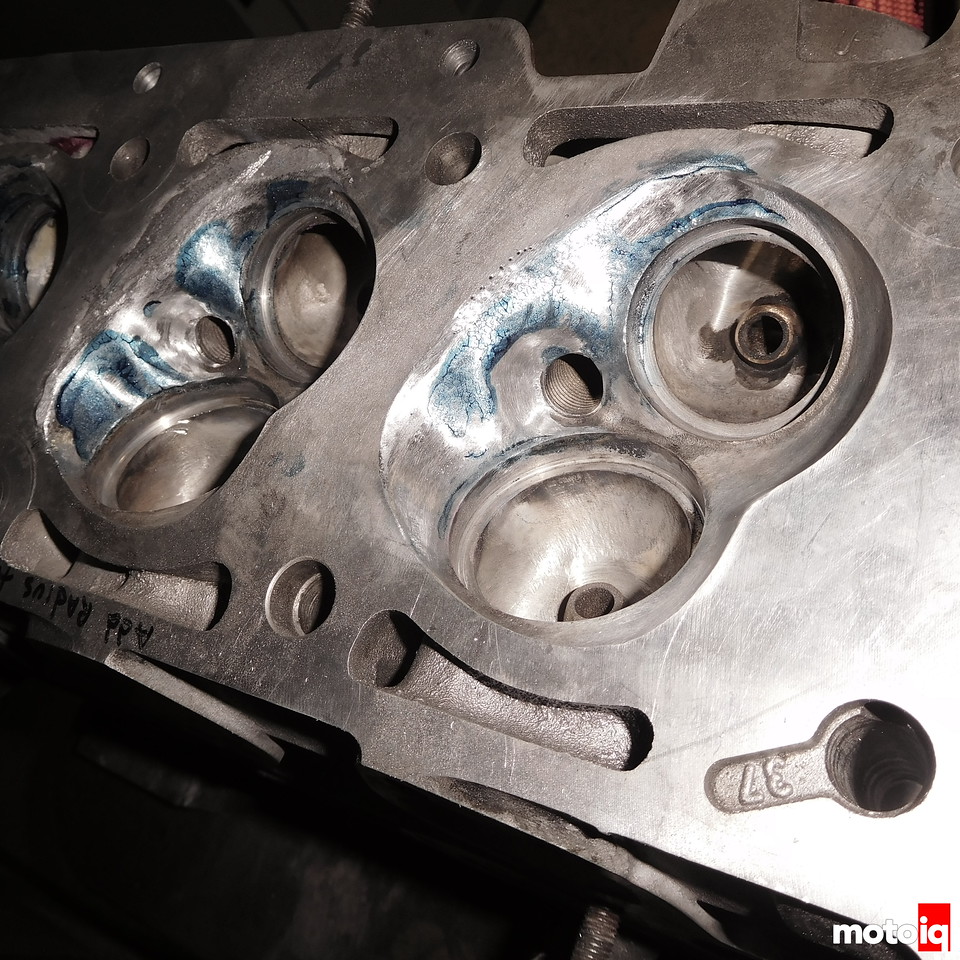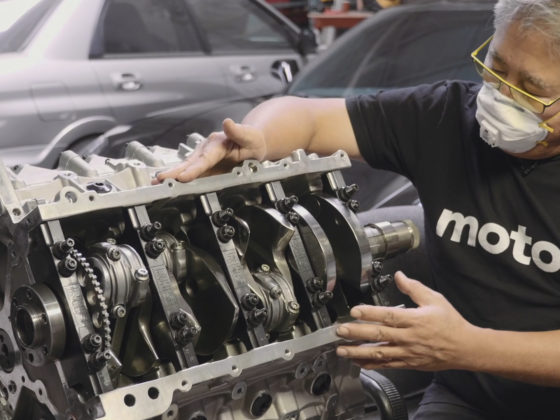BMW 2002-cylinder heads are not the worst cylinder heads ever made to try and improve but they are definitely in the running. The 2002 port runners are short and the short sides go right up to the back of the valve seat inserts and there is little to no short side radius. You can mess around with the port runners for months and never get them to flow much better. I have tried numerous times in the past with limited success. So, when Raffi, the owner of The Pit Stop, a high-end exotic car garage in Brisbane, Ca. told me to be creative and make it the best 2002-cylinder head ever, I may I confess, have possibly become sexually aroused. A good customer was giving me the rare chance, to do something well beyond the norm and ordinary. Something Great! Something Bigly!! Something Covfefe!!!
Since the gains to be gotten from the 2002 head are finite when it comes to just porting we had to think out of the box. To go beyond porting, we would have to think about thermodynamics and combustion. Internal Combustion engines work on basic Thermodynamic and a few other scientific principles. The prime thermodynamic principals include Volume, Pressure and Temperature. Each of these can refer to a number of states and actions in our engine. Volume can be noted as a measurement reference as to a cylinder’s Swept Volume. IC engines breathe on a “Per Volume” basis. There is also the Volume of the crankcase which also has its effects on operation, but we will pass that by for now. Without Pressure there would be no compression of the in-cylinder Air/Fuel charge, and there would be no external pressure on the Air/Fuel charge to assist it entering into the engine.
Atmospheric or Barometric pressure is how much the weight of the ocean of air that we live under is pressing upon us. This pressure is relative to our elevation in the Troposphere. Barometric pressure also changes with weather conditions. Barometric pressure is higher at sea level than it is on the top of a mountain. Or the higher one goes up into the Troposphere the less are the effects felt by the weight of our ocean of air. Temperature affects the amount of Oxygen in the air that we and our IC engines need to breathe and survive. Cooler temperatures will generally, but not always, provide more oxygen molecules per a given volume of air. Oxygen content is also affected by the amount of water in the air. But again, we do not want to make this story overly complex at this time.So, what does all of this mean? It means that our wonderful Internal Combustion engines are, at an elemental level, thermodynamically driven.
I spent some time thinking about what I had done to 2002 heads in the past and knew that I could just about port this thing with a sand paper roll and make it as good as it was ever going to get. Or I could put the cylinder head on Mister Flow Bench and do some testing and thinking. I began testing both CFM and velocity numbers in the port runners. I wanted to find out if this thing had any secrets. I needed to think positively! Try a new approach to thinking about this problem child and try something new.

Not every cylinder head’s air flow problems are located in the port runners. For some heads, you can grind in the runners until you start to see shapes in the port runner walls that look just like Jesus on a tortilla. That might get you an audience with the Pope, a room in a padded cell, but it will not likely proffer any helpful relatable airflow information. So, I started looking beyond the port runner and to the combustion chambers. I put some clay in the chamber and put the head back on Mr. Flow Bench. The intake air flow picked up! I did some more sculpting. The cylinder head was now traveling back and forth from my porting/work bench to Mr. Flow Bench. I had started to wear a game trail into the concrete floor. But the intake port runner air flow had continued to pick up. It picked up enough that the clay started peeling off the chamber walls. There was now too much air flow for the clay to adhere. Excellent!!!
I mixed up some epoxy and started filling in the combustion chamber areas where the clay had previously been. The next day after the epoxy had hardened, I started to do some conservative shaping. The flow slowly started to return to the numbers that I had seen in the day before, so I shaped the chamber some more. The head’s air flow kept getting better. I was now wearing a deeper path in the concrete floor between Mr. Flow Bench and my work table.
I continued this routine over the next few days until I had a definitive shape. What I have described here took many, many hours spread out over days of testing and shaping. This is very slow, detailed, and tedious work. It is not a box of Lego’s or a Christmas jigsaw puzzle prize from your favorite Aunt. Airflow Trolls do not suddenly jump up out of Mr. Flow Bench and tell you what you should do. You have to listen; watch the numbers and look for clues. Use your flow tools in the port runners, watch for turbulence and dead spots, etc. You have to think and figure it out with this and other such cases by trial and error. Cylinder heads do not come with improvement instructions with regards to port flow CFM and especially not port velocity.

I wanted the intake flow to spiral around and down the cylinder bore. Not as per stock which had the charge blowing out the intake valve and straight across and out the exhaust port during overlap. I did a little backyard wet flow test to confirm that I was moving in the right direction. I was. After I had tested my modifications backwards and forwards for a few days. I made a silicone mold of the port and then had my friend Robbie, The Welder, weld up the four combustion chambers.





34 comments
GREAT ARTICLE!!! invaluable insight!! thank you!!
Thank you Wes.
The quench in the combustion chamber will be improved as well as the flow quality lending to better mixture distribution in the cylinder. The BSFC should go down and the engine will probably like less timing. This is somewhat reminiscent of the Soft Head porting and combustion chamber modifications that Larry Widmer did in the 80’s.
Thank you Mike.
Yep, or people like Harry Weslake way before that…. Hemi combustion chambers tend to create low compression on smaller displacement engines. Story of my life, as I tend to mess with them in my spare time. You could actually diffuse mixture from outside the quench area if you make small channels running towards the spark plug. if the quench angle is actually quite steep on a 2 valve with the spark plug on the side. Rounding of the quench also helps a bit. But you should only do that if your can maintain a high enough compression ratio. Otherwise compression should always be leading.
Then again: port angle an radius are a lot more important, but also the stuff where it becomes really tricky. Not so much for grinding, but actually changing the angle and port itself without casting a new head.
Funny you should mention that. I used the same technique in building up my Honda Ruckus Scooter. Had the chamber welded up to make a lot of quench and to bring up the compression ratio to over 13:1. Then I added the channels to the plug because I read some white paper about it. This thing ran really hard for a 50cc scooter, it could go 60 mph with my fat ass on it and I could outrun guys with a 125cc GY6 engine swap. Many other people have tried to follow my lead and build a fast 50cc but no one has come close!
Way to go Don!! You are the Professor of porting.
Thanks love, I’ll cook dinner tonight for that.
Don
Great to see you “un-leashed” in your forte!
Good onya Don, RF.
Thank you Fred, Mister Indian!
That takes an impressive amount of knowledge and determination to modify a cylinder head with such a poor overall performance, and see the significant improvement that was displayed here. Sounds like many hours of work and quite a bit of patience were required, as well. Very interesting article, well written and thoroughly descriptive in content.
Such a cool article, the old school art of hot rodding.
Thank you for sharing!
Thank you Miguel for your nice comment. Old is the optimum word in my particular case.
Stay tuned, there is more coming.
Don
Dear Don,
Many thanks for the article about the 2002 cylinder head modifications. It demonstrated an unusual and innovative approach to gas flow. I was particularly impressed by the test facilities that you have on hand to prove your ideas before putting them to trial as is the traditional suck-it-and- see method. It must save a lot of scrap! Also what is impressive is the outside specialist support that you are able to call upon and your patience and dedication to the project. Sadly for me, you are now going way beyond my own capabilities these days.
Best regards
Bill
Thank you Bill. Nice to know that MotoIQ is making it all the way to England
A well written (and entertaining!) article. Folks with this kind of dedication and who make fast engines. It’s all about brains and sweat.
Thank you Kris
Jackson
Congratulations Don you are The Man.
Great article Don! Wish I had known about Replika Machinen when I was driving my 76 2002. To date one of my favorite cars. As a current customer I appreciate your dedication to the art of air flow and the paramount pursuit of perfection!
Thank you Jeromey
Great article. I am actually about to start on a rebuild project with my 2002 (with x60,000 miles). I won’t be able to to this level work certainly! Any recommendations for shops to do more basic head work in the Bay Area?
Thank you for your comment. We can and do, do less involved cylinder head work. Mike asked me to feature this project as it shows what can be accomplished by people with lots of experience in cylinder head and engine work.
Call me and we can discus your project.
Don
Great article Don! You are a wealth of information. On a side note, Don has been working with us on a new cylinder sleeve design. Stay tuned for more on that.
Thanks Jeff, I guess I better call you!
Good job. It is a good article for those that want to learn.
It is unfortunate that most of the readership do not understand how much work it
is to do the work on the parts and test them AND then generate the words to
explain it to them. I hope they pay you for these efforts.
Regards,
HB2
Thank you Harold for your comments and encouragement.
Don
Don, many people believe that a cylinder head is just a lid with holes for the valves; you’ve proved that it is much, much more.
It was a lot of hard work, but what a good job well done.
Eddie.
Coming from a world class restoration expert like you that is high praise.
Hope you are doing well over there.
Thank you, Don
Thank you Billy.
Three positive comments from over “The Pond”. Spanning the Wide World of Air Flow.
Don
I’m really interested in seeing what kind of numbers the little m10 will put down with that kind of flow improvement..
Thank you PJ.
I am only involved with the cylinder head. At this point what, when and where as far as the rest of the engine goes are a mystery.
Don,
what ‘s and arm wavy cost to do this work AND now that you’ve done all this learning would a 2nd head like this one be cheaper?
I think that you are asking about the price to reproduce this cylinder head. Cheaper???
I have been porting 2 and 4 stroke cylinder heads for over 40 years. What is that life experience and knowledge worth?
It has taken a LOT of work to get to the combustion chamber and the CFM to the point that it is currently.
Will additional “copies” of this cylinder head be less expensive than the original? Possibly, that depends upon the demand.
If you are truly interested then you can call me and we can discuss it.
Don Redmon
Replika Maschinen, Inc
831-359-0863